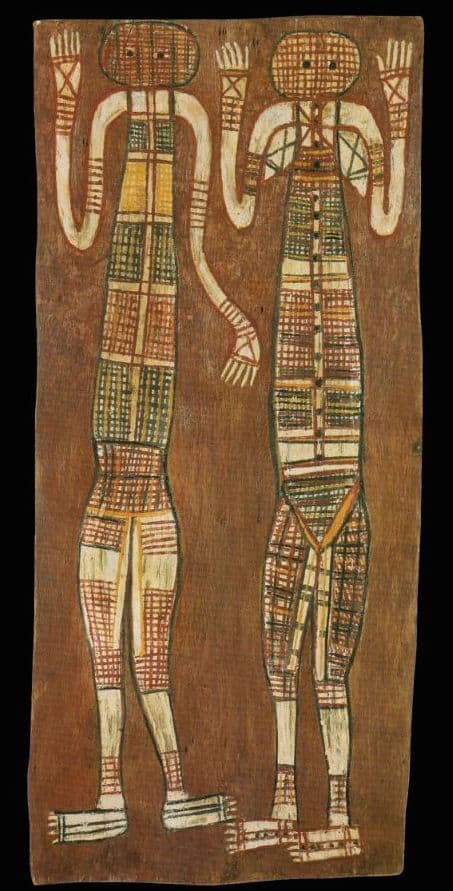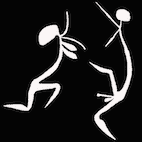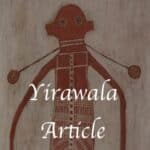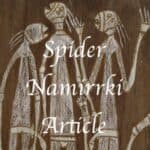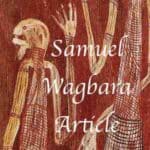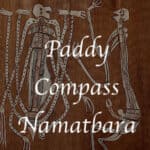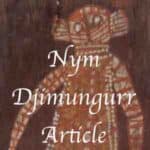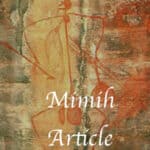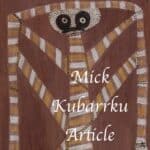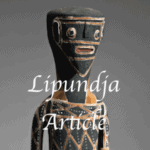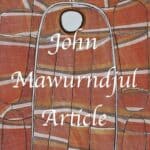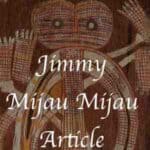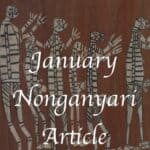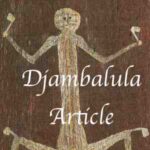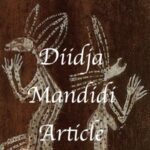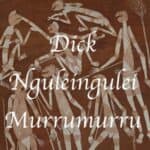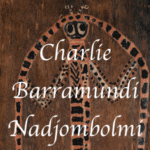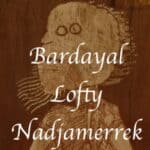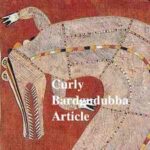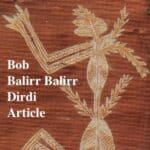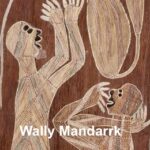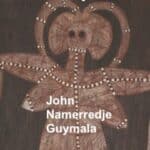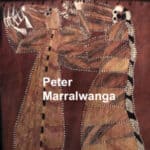Jimmy Mijau Mijau Crocker Island Bark Painter
The Sorcerer of Croker Island
Jimmy Midjaumidjau, whose name appears in various historical records as Jimmy Mijau Mijau, Midjaw Midjaw, Midjau Midjau, and Jimmy Midjawmidjaw, was born around 1897 in Minjilang on Croker Island, off the coast of Western Arnhem Land. A Kuninjku-speaking artist, Midjaumidjau stands as one of the great early bark painters—an artist whose works were never created simply for aesthetic enjoyment, but rather to invoke, contain, and transmit ancestral power. In his time, bark painting was not yet recognised as “fine art” but operated within a sacred, ceremonial framework—an embodied system of spiritual law.
Midjaumidjau’s paintings transcend narrative illustration. Many of his most powerful barks are linked to Marrkidjbu, or sorcery—a concept too often misinterpreted in Western contexts. In Kuninjku culture, this form of spiritual engagement is an ancestral technology, invoking justice, influence, and metaphysical correction. His painted figures possess a rhythmic, dreamlike movement: limbs flow unanchored by anatomical logic, embodying spirit rather than structure. Faces often blend human, insect, and totemic forms, while compositions hum with ceremonial intensity.
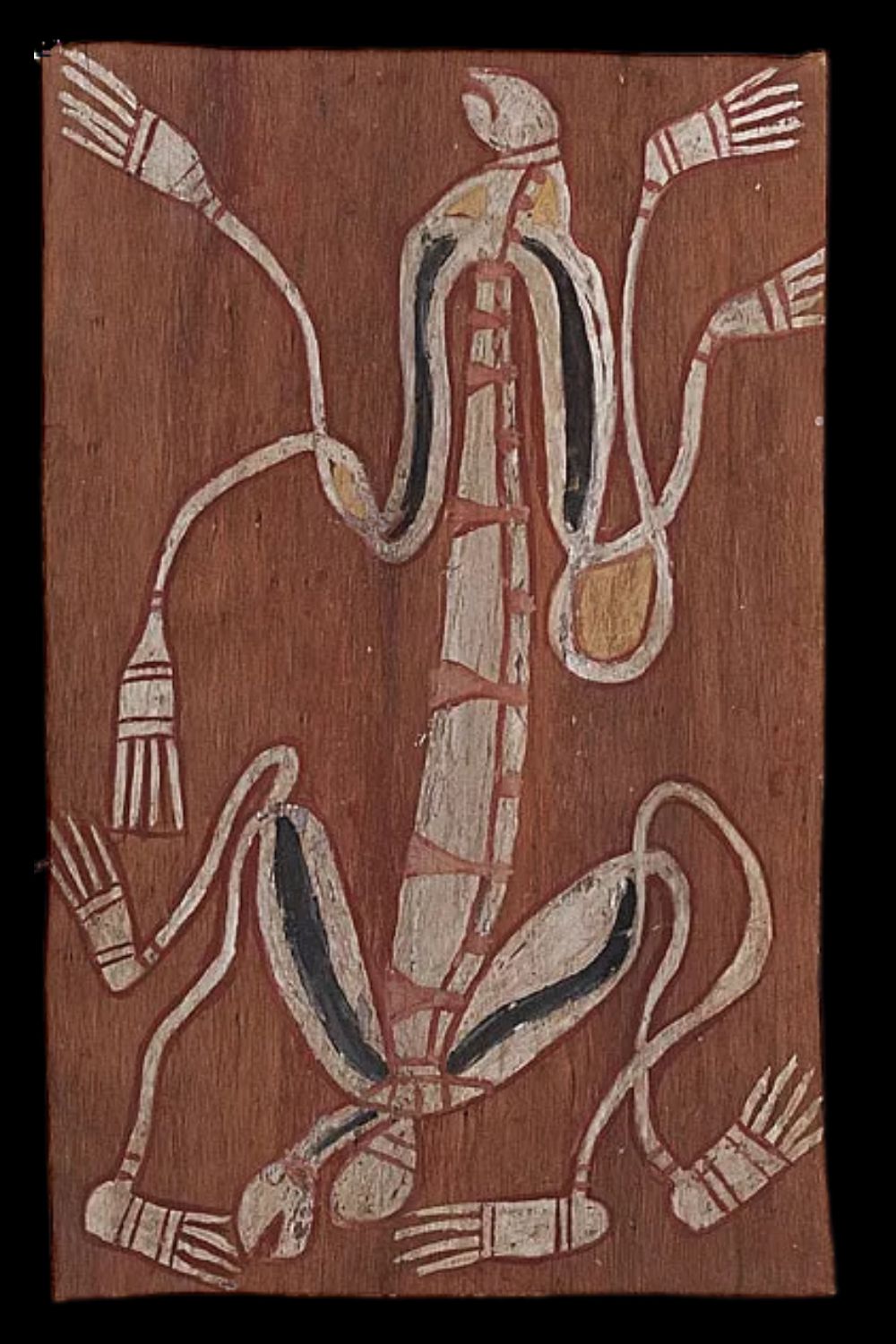

If you have a Jimmy Mijau Mijau bark painting to sell please contact me. If you just want to know what your Jimmy Mijau Mijau painting is worth please feel free to send me a Jpeg because I would love to see it.
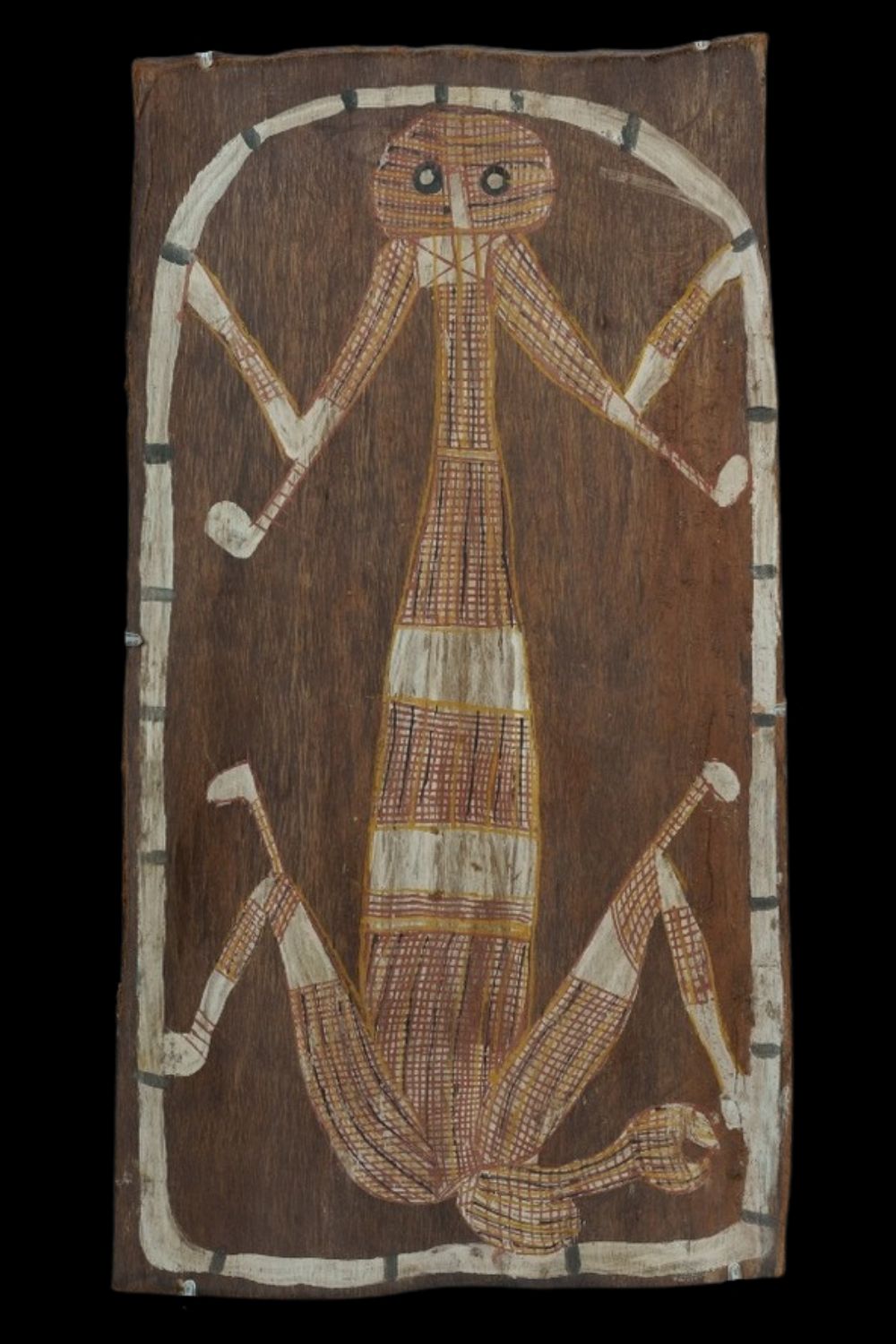
Early Works (Pre-Mission Influence)
The early works of Jimmy Midjaumidjau—largely collected by anthropologists in the 1940s and 50s—are rare, deeply traditional expressions of pre-contact Aboriginal belief systems. These bark paintings are visually raw, boldly composed, and rich with esoteric meaning. They often feature prominent genitalia, simplified internal anatomy such as spines, and exaggerated limbs that snake across the bark surface with deliberate abstraction. Cross-hatching (rarrk) appears only sparingly, with fields of flat ochre dominating. Facial profiles, often ant-like, reject Western portraiture and instead gesture toward ancestral identity. These early works share affinities with artists like Paddy Compass Namatbara and Namatbara Wagbara, but are distinguished by their sorcery-infused iconography. They function not just as cultural records, but as spiritual instruments—active agents within Kuninjku cosmology.
Later Works (Mission-Era Production)
As Croker Island came under the increasing influence of mission life, Midjaumidjau adapted his practice for the new economic and social realities. His later works, often produced for sale, exhibit a clear shift in style. Rarrk becomes more prominent, introduced and refined under the influence of Yirawala, who helped bring Arnhem Land art to broader attention. Genitalia vanish—an erasure enforced by missionary oversight—and figures become less confrontational but no less alive. Circular, mouthless faces stare directly forward, their silence resonant. In some of his most memorable later works—such as depictions of the Mammoth Spirit—figures stretch impossibly long, their forms stylised to the point of surrealism. Yet even these later paintings retain the charge of their predecessors: the sensation that one is not simply viewing art, but entering a space of power.
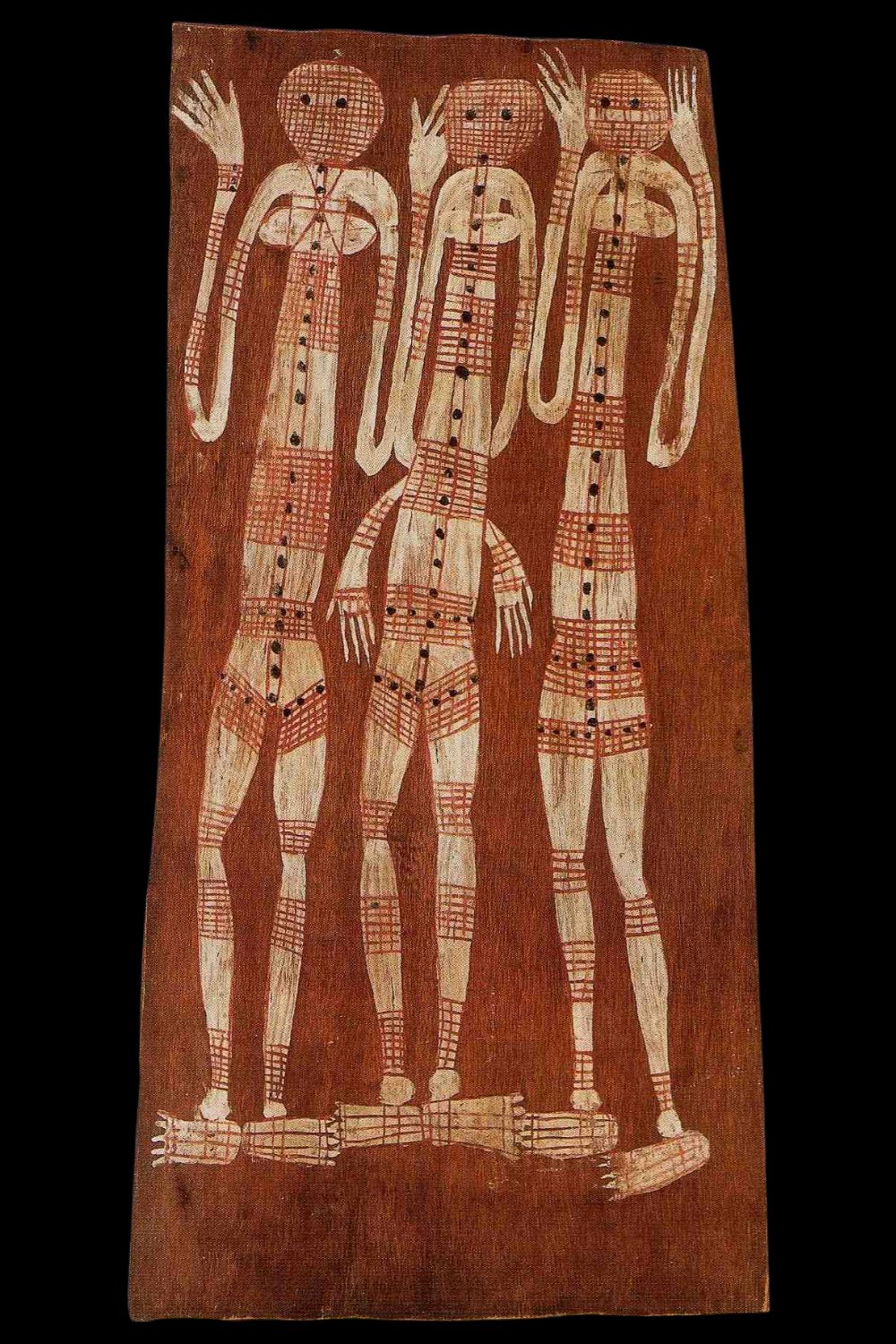
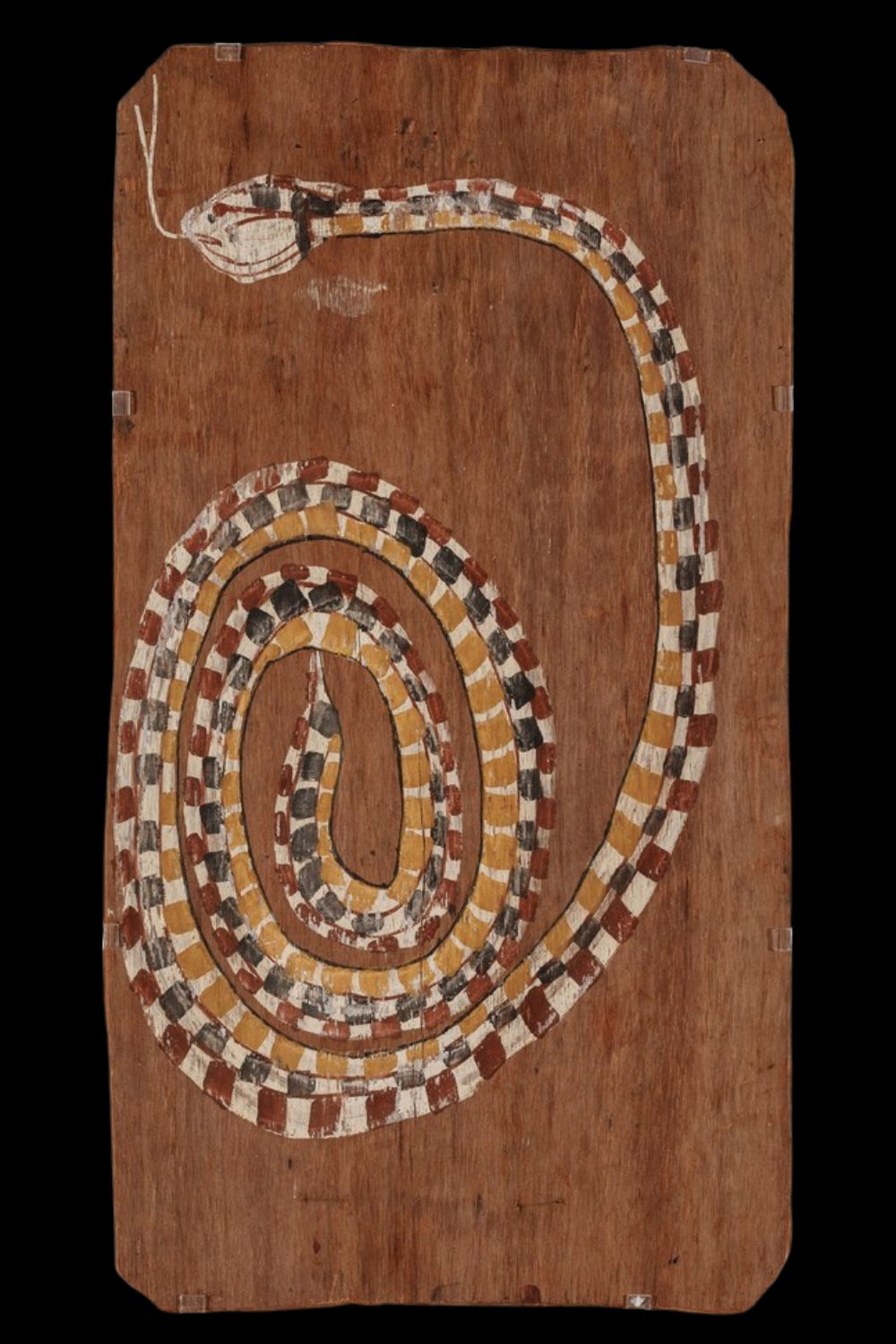
Jimmy Mijau Mijau did do paintings of animals including Kangaroos, turtles, snake, fish, and echidna. These animal barks are nowhere near as popular with collectors as his spirit figures. He also painted depictions of Namarrkon the Lightning spirit. I like his earlier works for the pure freedom and lack of inhibition and convention.
Bark paintings by Samuel Wagbara Spider namirrki and Paddy Compass Namatbara are sometime mistaken for the better known Jimmy Mijau Mijau
Conclusion: The Enduring Power of Midjaumidjau’s Vision
Today, Jimmy Midjaumidjau is recognised not only as a stylistic innovator but as a critical custodian of Kuninjku spiritual knowledge. His work offers a rare visual grammar for understanding the complexities of sorcery, ceremony, and cultural resilience in Western Arnhem Land. For collectors, institutions, and researchers, a Midjaumidjau bark is more than a visual artefact—it is a portal to a world where painting, power, and ancestral law converge. As interest in early Arnhem Land bark painting continues to grow, Midjaumidjau’s legacy stands as one of the most spiritually potent and visually distinctive in the canon of Aboriginal Australian art.
Very little information is available on this artist. Jimmy was born in Minjilang on Crocker Island around 1897 and died in 1985. He spoke Kuninjku, language. If anyone knows more information about the life of Jimmy I would love to hear from them. I would be more than happy to add it to this article.
Right: Jimmy Mijau Mijau with a bark painting of a Namarrkon Spirit
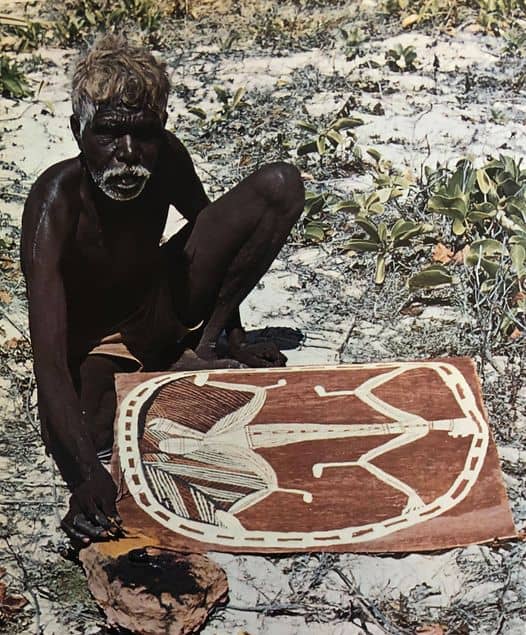
All images in this article are for educational purposes only.
This site may contain copyrighted material the use of which was not specified by the copyright owner.
Meaning of some Jimmy Mijau Mijau Bark paintings
The Malamu Dreaming
This painting tells the story of Malamu, a legendary rainmaker and powerful sorcerer, revered among the Kunwinjku people for his ability to conjure storms using a sacred pearl shell. A man of great mana and social standing, Malamu lived with his first wife and their three children when he took a second wife—an act permissible by law but fraught with emotional peril.
At first, the two wives lived harmoniously, but over time jealousy and resentment brewed between them. Their constant quarreling soon escalated into open defiance—not only of one another but of Malamu himself. His attempts at mediation only united the women against him. They taunted him, refusing to sleep with him, and his clansmen ridiculed his inability to control his household. Malamu’s shame grew unbearable.
Determined to end the strife, Malamu called upon his sorcery. Using his sacred pearl shell, he summoned a torrential rainstorm. As water flooded the camp, he led his wives to higher ground—to a secret cave he alone knew. There, under the guise of shelter, he abandoned them. After crossing a nearby river, Malamu turned and used his magic to transform the two women into stone.
Yet remorse soon overwhelmed him. He returned days later to undo the spell, but the transformation was irreversible. The stones—rounded and breast-like in form—remained. In despair, Malamu used his final act of sorcery to turn himself into stone, so he could remain forever beside his wives.
These stones still stand on a high hill known as Obirr, near the sacred site of Ubirr. To this day, the Gungarre and Gunwinggu people identify them as Malamu and his two wives—an eternal reminder of the human complexities of love, power, and regret, preserved in stone and in story.
